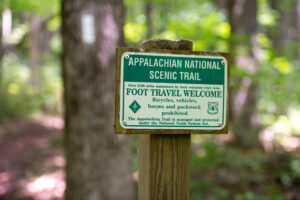Learn More
Media Room
A.T. Facts
- The Appalachian National Scenic Trail is the longest hiking-only footpath in the world.
- Completed in 1937, the A.T. is a unit of the National Park System. It is managed under a unique partnership between public and private entities led by the Appalachian Trail Conservancy
- The Trail is 2,197.4 miles long, passing through 14 states. This distance typically changes slightly each year due to footpath relocations and more precise measurement techniques.

- The Trail’s southern terminus is at Springer Mountain, Georgia, and the northern terminus is at Katahdin, Maine.
- 5,000+ volunteers contribute roughly 176,500 hours to the A.T. every year.
- More than 260 backcountry shelters exist along the Trail.
- Virginia is home to the most miles of the Trail (about 550), while West Virginia is home to the least (about 4).
- Maryland and West Virginia are the easiest states to hike; New Hampshire and Maine are the hardest.
- The total elevation gain of hiking the entire A.T. is equivalent to climbing Mt. Everest 16 times.
- The A.T. passes through six National Park Service units, including: Great Smoky Mountains National Park, Blue Ridge Parkway, Shenandoah National Park, Harpers Ferry National Historical Park, Chesapeake & Ohio Canal National Historical Park, and Delaware Water Gap National Recreation Area
- The A.T. also traverses eight National Forests, which include: Chattahoochee National Forest, Cherokee National Forest, Nantahala National Forest, Pisgah National Forest, Jefferson National Forest, George Washington National Forest, Green Mountain National Forest, and White Mountain National Forest
- The A.T. also travels through two wildlife refuges: Wallkill River National Wildlife Refuge and Cherry Valley National Wildlife Refuge
- The A.T. is home to an impressive diversity of plants and animals, including 1,800 endangered or rare species populations. Some animals you may see include black bears, moose, porcupines, snakes, woodpeckers, and salamanders. Some plants you may encounter include jack-in-the-pulpit, skunk cabbage, and flame azalea.
A.T. Hikers
- Over 3 million visitors walk a portion of the A.T. each year.
- The A.T. has hundreds of access points and is within a few hours’ drive of millions of Americans, making it a popular destination for day-hikers.
- It takes roughly 5 million steps to hike the entire A.T. — whether that is over a series of section hikes or one “thru-hike” in a single year.
- “Thru-hikers” walk the entire Trail in a continuous journey. “Section-hikers” piece the entire Trail together over years. “Flip-floppers” thru-hike the entire trail in discontinuous sections to avoid crowds or extremes in weather, or to start on easier terrain.
- 1 in 4 who attempt a thru-hike successfully completes the journey. See the latest thru-hiking statistics.
- Most thru-hikers walk north, starting in Georgia in late winter / early spring and finishing in Maine in fall, taking an average of 6 months.
- Foods high in calories and low in water weight, such as Snickers bars and Ramen Noodles, are popular with backpackers, who can burn up to 6,000 calories a day.
- Hikers usually adopt “trail names” while hiking the Trail. They are often descriptive or humorous. Examples are “Eternal Optimist,” “Thunder Chicken,” and “Crumb-snatcher”.
About the Appalachian Trail Conservancy

Founded in 1925, the Appalachian Trail Conservancy works passionately to manage and protect the Appalachian National Scenic Trail. As the only non-profit devoted exclusively to the entirety of the Trail and its landscape, we endeavor to keep its vast natural and scenic beauty healthy, resilient, and connected, so that everyone can experience its transformative power for generations to come. Together with our supporters, partners, and thousands of volunteers, we keep the Trail alive.
The ATC is largely funded by private donations from individuals, foundations, and corporate partners. Their support ensures that the one-of-a-kind A.T. experience is protected from development, increasing use of the outdoors and other impacts.
An all-volunteer staff in Washington, D.C., managed the organization for its first four decades. With central offices in Harpers Ferry, West Virginia, a quarter-mile from the Trail since 1972, the ATC today has a full-time staff of about 60, more than a dozen part-time and seasonal employees, and is governed by a 19-member Board of Directors. It has an annual operating budget of $14 million. In addition to its Headquarters and Visitor Center in Harpers Ferry, the ATC manages Visitor Centers in Damascus, Virginia, and Monson, Maine.
Media Contact:
Ann Simonelli, Director of Communications
Email: asimonelli@appalachiantrail.org
Phone: 304-885-0482
Discover More

Learn More
About the ATC
We are the stewards of the world’s longest hiking-only footpath, the Appalachian Trail.

Stay Informed
Latest News
Read the latest news and updates about the Appalachian Trail and our work to protect it.

ATC's Official Blog
A.T. Footpath
Learn more about ATC's work and the community of dreamers and doers protecting and celebrating the Appalachian Trail.
